
Jump to:
Most people’s first encounter with Wasabi is as the spicy green paste that sits between the rice and the fish in sushi. Wasabi, which is often referred to as Japanese horseradish in English, is a member of the plant family Brassicaceae, which also includes horseradish and mustard.
In this article, we shall look at what Wasabi is and its history, where it is grown, look at the differences between fake and real Wasabi, and why real Wasabi is so expensive. We shall then look at some potential health benefits of eating Wasabi and how Wasabi is used in food, as well as options for purchasing real and processed Wasabi.
What Is Wasabi?
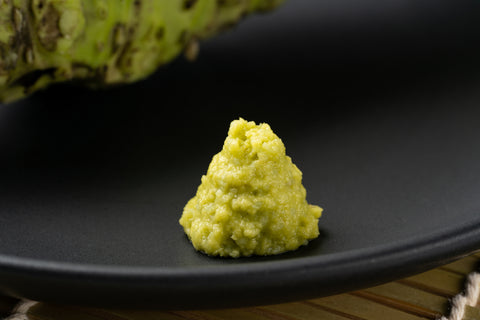
It is fair to say that Wasabi divides opinion. It is not just children who order their sushi Wasabi-nuki (without Wasabi). However, whether you are a fan or not, it’s hard to deny that it currently plays a vital role in Japanese food culture. If you have only seen Wasabi when it is served with your raw fish, or possibly in a toothpaste-like tube, you may wonder what it actually is.
Although used similarly to other condiments, Wasabi is more like a root vegetable. Real Wasabi is made from the rizhome of the Wasabi plant. In case you were wondering, the rizhome is the underground stem, which is finely grated to create Wasabi paste.
When you eat Wasabi, you are hit by a burst of spiciness that can cause your eyes (or nose) to stream similar to the effect of mustard or horseradish. There is a good reason for this, as Wasabi includes the same organic chemical compound, allyl isothiocyanate. This compound has a volatile nature, so it evaporates and dissipates quickly. This is the reason that the spiciness experienced with Wasabi is short-lived when compared to something like hot sauce.
History Of Wasabi
So, when did Japanese people first start using this spicy root as part of their diet? We should first say that it was used as medicine hundreds of years before it became part of Japanese cuisine. In fact, the name Wasabi appears in the “Honzowamyo”(本草和名), which is the oldest Japanese dictionary of medicine still in existence, and said to have been written between the years 901 and 923.
It seems that the history of Wasabi cultivation began in the early Edo period when it was favorably received by Tokugawa Ieyasu, and then first used as a seasoning for sushi during the Bunka/Bunmei era of the Edo period (1804-1830). Whereas the taste of sushi has now become inseparable with Wasabi for many of us, it is likely that it was first used because people knew instinctively, or alternatively from experience, that Wasabi counteracted the fishy smell and prevented food poisoning. Taking a hint from how tea was processed, people began drying and powdering Wasabi, and in the early 1970s, it began to be used as Wasabi paste in small packets.
Where Is Wasabi Grown?
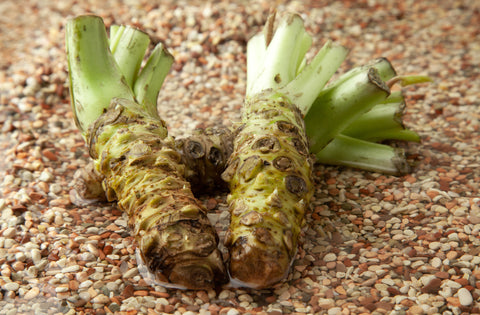
It is said that the ideal conditions for Wasabi production are an abundance of spring water and a moderate climate, and these conditions are perfectly met in the two major Wasabi-producing areas of Japan, the prefectures of Shizuoka and Nagano. Together, these make up more than 90% of production in Japan.
Shizuoka has some of the largest “Sawa” wasabi farms in Japan. “Sawa” is the highest-grade mountain stream variety of Wasabi, which grows in shallow cold water.
The Daio Wasabi farm in Azumino, Nagano, is the largest Wasabi farm in Japan, at over 15 hectares. This farm has been run for over a century and boasts an abundance of natural beauty.
What Is The Difference Between Real And Fake Wasabi?
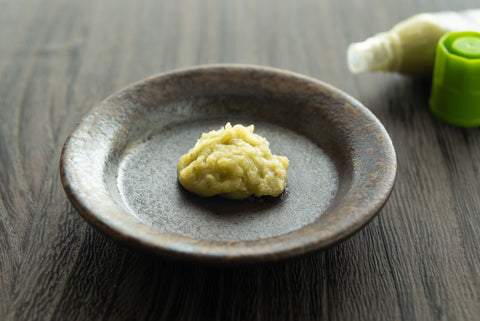
Whereas, as mentioned earlier, authentic Wasabi (or Hon-Wasabi) is obtained by grating the rhizome of the Wasabi plant, not all Wasabi is real. Fake, or imitation Wasabi, on the other hand, may have a small amount of real Wasabi in it, but is typically made by blending horseradish, mustard, and vinegar with green food coloring and fillers such as corn starch. So, why are there two types? Why doesn’t everyone just use real Wasabi?
The main reason is cost. The Wasabi plant can only be grown in specific environments. Cultivating Wasabi plants is a challenging endeavor and requires specific temperatures, light exposure, and soil conditions. What is more, Wasabi plants take their time maturing. Indeed, it takes around two years for the roots to grow. This combination of factors makes Wasabi one of the most expensive crops in the world to produce.
As a result, imitation products that mimic real Wasabi’s texture, flavor, and appearance have sprung up as popular alternatives as a means of making Wasabi cheaper and more accessible. These products are widely available in supermarkets and restaurants. When it comes to Sushi, it is likely that only really the top-end restaurants will be using the proper stuff.
So how can you tell the difference between the two? Freshly grated Wasabi will have a pale green color, whereas imitation Wasabi, packed full of colorants, will often have a deeper green color. The main difference, however, is the taste. If you have only ever experienced fake Wasabi before, you will notice that real Hon-Wasabi has a more complex flavor profile than the one-dimensional powerful blast of spiciness given by fake Wasabi. Real Wasabi not only has a spicy kick but is balanced out by a sweetish aftertaste.
Is Wasabi Good For You?
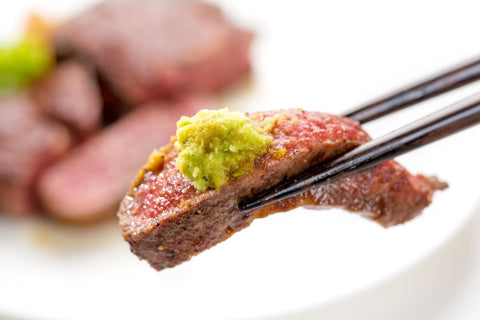
We have already touched on the fact that Wasabi is useful for killing bacteria and preventing food poisoning, but the health benefits do not stop there. Used for centuries in Japan for medicinal purposes, modern research has revealed the following beneficial effects of eating Wasabi. In particular, the two major components of Wasabi, isothiocyanate and allyl isothiocyanate have been shown to lower inflammation, provide potent antioxidants, act as antimicrobial agents, support digestive health, lower the risk of cancer, and even support cognitive health.
On this last point, the Japan Times has published an article describing a study undertaken by Kinjirushi and Tohoku University that found significant improvements in the episodic and working memories of a group taking a supplement containing a key component of Wasabi compared to those taking a placebo.
It is worth mentioning, however, that you will need to consume real Wasabi to get these benefits, and as there are only small amounts of the real thing in imitation Wasabi, it is unlikely to be very beneficial for your health.
How Do Japanese People Enjoy Wasabi?
Wasabi is most commonly eaten with raw fish, in the form of sushi or sashimi, and it is also often used when making sushi at home (check out these recipes for Temaki sushi and Maki sushi). Additionally, Wasabi can be used whenever there is a desire to give a Wa-fu flavor kick to a dish, such as soba noodles, or in dips for meat, such as when mixed with soy sauce to make Wasabi-joyu.
Options For Purchasing Wasabi
Whereas imitation Wasabi is available at all supermarkets and even convenience stores, it is harder to get hold of real Wasabi. Some of the larger supermarkets carry it, but a safer bet is grocery floors of large department stores such as Mitsukoshi or Isetan, or specialty stores.
Another great place to get Hon-wasabi products is the Japanese Taste website. Kameya uncompromisingly uses only real Wasabi, sourced from Shizuoka Prefecture, in its products rather than padding out the product with cheaper Western horseradish as is the common practice.
Kameya Coarsely Grated Wasabi Paste 50g
Whereas most Wasabi paste will use Western horseradish, this award-winning product from Kameya uses 100% Japanese Wasabi, which gives it a greater pungency than its rivals, making it an excellent product both for use with sashimi and as an ingredient for dipping sauces.
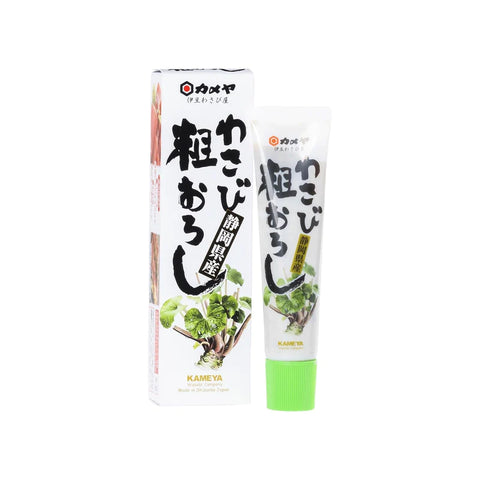
[callout-1]
Tamaruya Shizuoka Hon Wasabi Paste 42g
Tamaruya is a manufacturer-owned farm from Shizuoka that also offers authentic Hon-wasabi in paste form. Its combination of sharp punch and delicate aroma make it a perfect garnish for a wide variety of foods, including sashimi, sushi, steak, and soba.

[callout-2]
Wooden Japanese Wasabi Oroshi Grater & Paddle
If you decide to forego using paste and grind your own Wasabi, you should definitely check out this beautifully crafted wooden grater for grating the Wasabi, which comes as a set with a paddle that is used for scraping off the Wasabi from the grater to ensure none goes to waste.
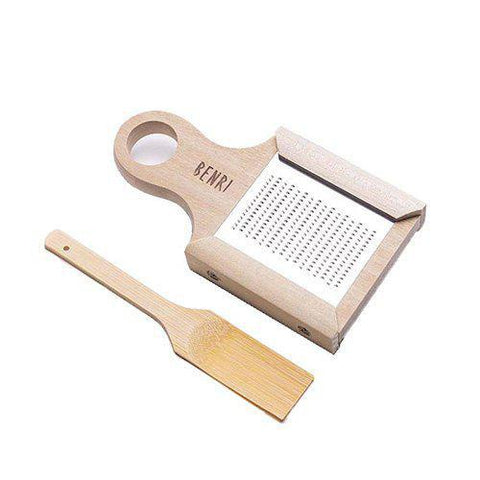
[callout-3]
In addition to the above, you can also find a large range of Wasabi-flavored snacks, and other Wasabi products, including Furikake rice seasoning and Wasabi powder on the Japanese Taste site.
Wasabi -The Green Condiment Intrinsically Linked To Japanese Food Culture
Love it or hate it, Wasabi has an undeniable place in Japanese food culture, particularly due to its association with Sushi, and dishes such as Tempura and Soba. Highly nutritious when enjoyed in its “real” form, Wasabi can also be enjoyed more economically in processed paste form, which is readily available in most supermarkets and even convenience stores.
Are you a Wasabi fan or is it not your thing? Let us know in the comments.


0 comments